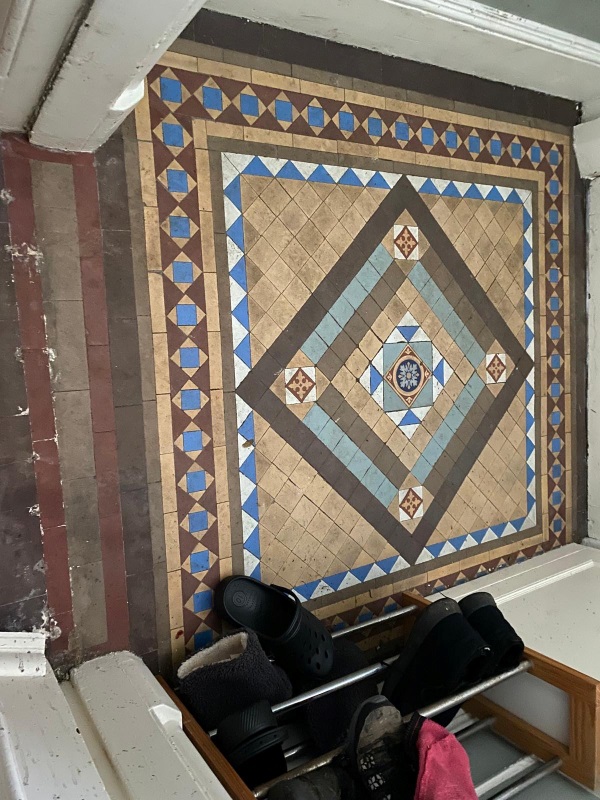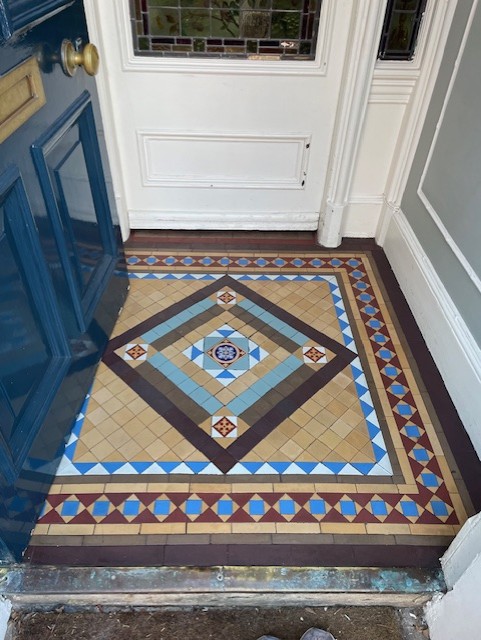I was recently contacted by a homeowner in the Trinity district of Edinburgh, who owns a charming Victorian property. They had discovered a stunning original Victorian tiled floor in the vestibule that had been covered up for some time and was now in need of some TLC. The tiles were largely intact however they were very badly soiled, covered in adhesive residues, and dulled by decades of grime and neglect.

Victorian tiles are a classic feature of period homes, often made from encaustic or geometric clay tiles. They’re very robust but can suffer damage or lose their vibrancy if not properly maintained. With the right cleaning products and equipment, they do come rather well and having seen some of the examples on my website of similar floors they were keen for me to work the same magic on their floor.
It wasn’t a large area so after running a few tests and measuring up I provided them with a quote that included deep cleaning the tiles including removing the adhesive and deep-seated dirt and then add a sealer for protection. Happy with the quote I got the go ahead to do the work and a date was agreed for my return.
Cleaning a Victorian Tiled Vestibule Floor
The first stage was to prep the area for work. I then applied a strong dilution of Tile Doctor Remove & Go, a powerful stripper designed to break down old sealers, adhesives, and heavy soils. The product was left to dwell for fifteen to twenty minutes before being agitated with a rotary floor machine fitted with a black scrubbing pad. This started to lift away years of embedded dirt and residue.
In areas with particularly stubborn adhesive patches, I used a handheld scraper and neat Tile Doctor Remove & Go where needed. The grout and edges were detailed using stiff brushes and handheld rotary pads. After the initial clean, the floor was thoroughly rinsed with clean water and all the fluids extracted with a wet vacuum.
The tiles were then treated to an acid wash using Tile Doctor Acid Gel, an acid-based gel cleaner that further cleans the tiles and removes mineral deposits. The extra level of cleaning really helped to bring out the original colour in Victorian tiles, it also neutralises the floor after the use of alkaline cleaners.
Victorian tiles are clay-based and quite porous, so it’s essential the floor is completely dry before sealing. I left the floor to dry for several days, using air movers to assist the process.
Sealing a Victorian Tiled Vestibule
Upon return, I tested the moisture levels to ensure it was ready to seal. The readings were fine so the first of two coats of Tile Doctor Colour Grow was applied to the floor. This is a breathable, matt, colour-enhancing impregnating sealer that works really well on Victorian tiles and is also externally rates so ideal for a hallway of vestibule. This product not only protects the tiles from staining but also lifts and intensifies the natural tones in the red, black, and ochre patterned floor.
The transformation was dramatic. What was once a dull, neglected floor is now a vibrant and character-rich entranceway, showcasing the home’s original period features. The intricate patterns of the Victorian tiles are fully visible again, and the sealer gave them a lovely satin appearance. The homeowner was delighted and how well the tiles responded.

Before leaving I took time to discuss aftercare which for a sealed tiled floor, I recommend the use of Tile Doctor Neutral Tile Cleaner which is a gentle yet effective product that won’t erode the sealer.
If you have a period floor in need of restoration, I cover the Edinburgh area and would be happy to provide a free site visit and quotation. Victorian tiles can last generations with the right care—get in touch to bring yours back to life.
Source: Victorian Floor Tile Cleaning and Renovation Service near Trinity Edinburgh